|
Gladiolus dalenii
(Dragon's head lily, Parrot lily, Natal lily, Sword
lily, African gladiolus)
[= Gladiolus dracocephalus, Gladiolus natalensis,
Gladiolus psittacinus]
Papegaaigladiolus, Wildeswaardlelie [Afrikaans];
khahle-e-kholo [South Sotho]; sidvwana [Swazi]; isidwi esibomvu, uhlakhale,
udwendweni [Zulu] Life
> eukaryotes >
Archaeoplastida >
Chloroplastida
>
Charophyta > Streptophytina > Plantae (land plants)
> Tracheophyta (vascular plants) > Euphyllophyta > Lignophyta (woody plants)
> Spermatophyta (seed plants) > Angiospermae (flowering
plants) > Monocotyledons > Order: Asparagales
> Family: Iridaceae > Genus:
Gladiolus
 |
 |
|
Gladiolus dalenii (orange form), eastern
Free State, South Africa. [photo
Colin Paterson-Jones ©] |
Gladiolus dalenii (yellow form), Vumba Rd.,
Zimbabwe. [photo Bart Wursten ©,
Flora
of Zimbabwe] |
 |
 |
|
Gladiolus dalenii (red form), Harare Rd.
near Headlands, Zimbabwe. [photos Bart Wursten ©,
Flora
of Zimbabwe] |
 |
 |
|
Gladiolus dalenii (yellow form) flowering
along the rim of Victoria Falls, Zambia. [photo Helen Pickering ©,
Flora
of Zimbabwe] |
Gladiolus dalenii flowering along the rim
opposite the Victoria Falls over the Knife edge bridge, Zambia. [photo
Helen Pickering ©,
Flora
of Zimbabwe] |
Information mainly from Goldblatt and Manning (1998),
unless otherwise indicated.
Identification
- Tall plants, usually ranging from 0.7-1.5 m high but can reach 2 m!
- Flowers are large, ranging from 60 to 100 mm long. The upper tepals are
35-50 mm long, far exceeding the recurved lower tepals.
- The dorsal tepal is distinctive in being strongly hooded.
- The perianth tube is 35-50 mm long.
- Flowers can range from red to orange (often with yellow marks on the
lower tepals), or from yellow to greenish (often with red or brown streaks
on the upper tepals).
Distribution and habitat
The most widespread and common species of Gladiolus,
occurring just about throughout the grasslands, savannas and woodlands of
sub-Saharan Africa. Its distribution also entends to the highlands of
southwestern Arabia (western Saudi Arabia and Yemen) and Madagascar. Within
southern Africa, it occurs in Zimbabwe, southern Mozambique, KwaZulu-Natal,
Eastern Cape, Free State, Mpumalanga, Gauteng and Limpopo. It is absent from the
winter rainfall (Cape) regions and from the semi-arid and arid regions,
including the karoo, Kalahari and Namib. Gladiolus dalenii is most common
in fairly moist habitats, especially in hilly country and upland grasslands.
Life cycle
- A geophyte, with large corms, usually measuring 20-30 mm in diameter.
- Flowering times:
- southern Africa: usually November to April although along the
KwaZulu-Natal coast it also flowers in September and October;
- tropical Africa: mid-November to May, sometimes as late as June;
- western and central Africa: May to August;
- Ethiopia: August and September; and
- Eritrea and Arabian Peninsula: January to March.
- Seeds measure 8-12 mm long by 5-9 mm wide, with well-developed wings
(the seed body is only about 2 mm in diameter).
Ecological interactions
Pollinators
Uses
- In southern Sotho medicine, Gladiolus dalenii is a common
constituent in the lenaka (medicine horn) of the South
Sotho-speaking herbalists (Watt and Breyer-Brandwijk 1962).
- In southern Sotho medicine, a decoction of the corm is used for treating
colds and dysentry. Alternatively, the smoke from the burning corm is
inhaled to treat colds, and the powdered corm is taken for treating dysentry
(Watt and Breyer-Brandwijk 1962).
- In West Africa, preparations of Gladiolus dalenii are used for
treating constipation and dysentry, and also evidently for treating snake
bites.
- Corms are used as food in the DRC, by first boiling them and then
leaching them in water for a week.
- Widely cultivated as an ornamental plant. In addition, it has played an
important role in the development of Gladiolus hybrids, being one of
the original species used in crosses to produce the large-flowered
Gladiolus cultivars, which are today amongst the most important
cut-flower crops.
Derivation of name
dalenii refers to Cornelius Dalen, a Dutch botanist
who became director of the Rotterdam Botanic Garden. From stock obtained from
KwaZulu-Natal, he distributed the species round Europe.
Links
Publications
- Goldblatt P. and Manning J. 1998. Gladiolus in Southern Africa.
Fernwood Press, Vlaeberg, Cape Town.
- Watt, J.M. and Breyer-Brandwijk, M.G. 1962. The Medicinal and Poisonous
Plants of Southern and Eastern Africa. Second Edition. E. & S. Livingstone
Ltd., Edinburgh.
Text by Hamish Robertson |
